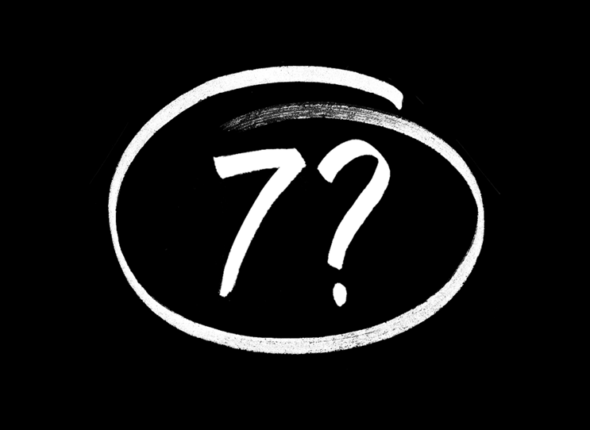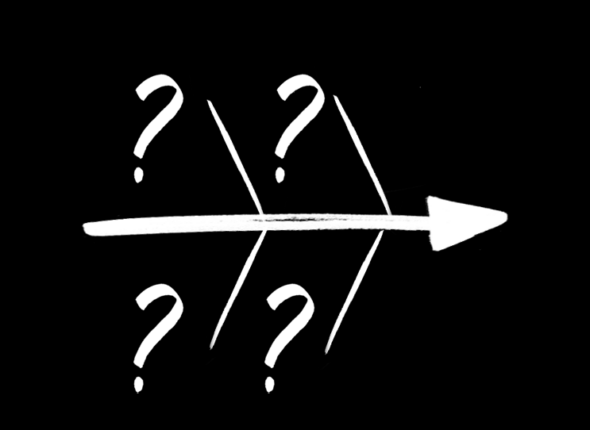-
-
-
-
-
We use the How Might We format because it suggests that a solution is possible and because they offer you the chance to answer them in a variety of ways. A properly framed How Might We doesn’t suggest a particular solution, but gives you the perfect frame for innovative thinking. The technique consists of reframing questions with the intention of turning those challenges into design opportunities. The way the question is asked suggests that a solution is possible and that it can be solved in several ways.
Every word of that question is designed so that psychologically people do not block themselves or feel afraid of proposing things, but rather to stimulate creative problem solving.
- How: assumes that there are solutions to that question, providing creative confidence.
- Might or We could: indicates that we can put ideas out there that may or may not work, but are still fine.
- We or Us: as its meaning indicates, it suggests that we are going to do it together and build on each other's ideas.
Implementation Steps of the Method
- Step 1: The team is placed in front of one of the groupings made and where the pain points, needs and motivations of the user have been identified. These #insights are essential to focus HMW questions on areas that really matter to the user.
- Step 2: Brainstorm HMWs – Put your problem statement and insights so that everyone can see them. Give everyone a set amount of time, and start to brainstorm How Might We statements. Go for quantity over quality, we want volume. This encourages us to think beyond the obvious and explore new and interesting ways of framing your design thinking challenge.
The questions are formulated starting with How could we? and focus on the user and its objectives. These questions must respect the following points:
- It should not suggest a solution: It might seem simple, but it's common to inadvertently embed a solution within a question, thereby narrowing the scope for creativity. For instance, “How might we assist Lina in adopting a step-by-step process to sign up for a gym?” presumes a specific solution path, limiting the brainstorming process. A more open-ended approach, such as “How might we facilitate Lina’s incorporation of a healthy training routine into her lifestyle?” widens the horizon, inviting a multitude of solutions where a step-by-step gym signup is just one of many possibilities, thus significantly broadening the creative landscape.
- It should contain the user, their problem/context and their need/pain point or insight: Crafting a problem statement from the user’s viewpoint is key, focusing on their needs and challenges. A broad question like “How might we increase our customer savings?” lacks user-specific insights. Incorporating the user’s context makes the problem statement more relatable and actionable: “How might we assist Lena in saving money effortlessly, considering her day is already packed with numerous tasks?” This approach not only highlights Lena’s unique situation but also prompts us to think deeply about tailored solutions.
- It should not be too broad or too narrow: Striking a balance in the scope of our How Might We (HMW) question is crucial for effective brainstorming. Too narrow, and we limit our creative possibilities; too broad, and we struggle to focus our ideation. The ideal HMW question opens the door to a diverse array of ideas while remaining focused enough to inspire actionable solutions. This balance affords us the creative freedom to explore a spectrum of innovations while ensuring they can be realistically implemented.
- It should contain emotional language: Incorporating emotional language into our problem statement deepens our understanding and connection with the user, highlighting the problem's immediacy. This approach transforms the user from a concept into a relatable figure. Emotional language provides context that not only outlines the user’s challenges but also fosters empathy. Consider these examples:
- How might we help Anna to save money effortlessly?
- How might we assist Anna, a hardworking single mother of two, to save money without hassle?
- The second statement vividly depicts Mina’s life, urging us to consider unique solutions tailored to her needs.
- Step 3: Question selection: After everyone has created their How Might We (HMW) statements, display them for all to see, whether on a table, wall, or digital board. Encourage the team to collectively review and organize them into overarching themes without overcomplicating the process. Discuss these themes together, focusing on what stands out as interesting, surprising, or innovative.
- Step 4: Select the best HMWs: Invite the team to vote on the most inspiring How Might We (HMW) statements, giving each person a limited number of votes. Whether in-person, using dots or marks, or online, through stickers or shapes on a whiteboard, everyone gets a few moments to select their favorites. :Then, gather the top-voted HMWs to propel into the ideation phase.
Tips
- Frame your HMW questions to be narrow enough to be actionable but broad enough to allow for creative solutions.
- Involve people from different backgrounds and disciplines to generate a wide range of perspectives.
- Avoid questions that imply a specific solution. Instead, use language that opens up possibilities.
Possible uses
- Kick off brainstorming sessions with HMW questions to guide discussions and spark creativity.
- Use HMW questions to explore new strategic directions or business opportunities.
- Redesign services by focusing on specific user pain points and opportunities for improvement.
You can download template here: HOW MIGHT WE
We use the How Might We format because it suggests that a solution is possible and because they offer you the chance to answer them in a variety of ways. A properly framed How Might We doesn’t suggest a particular solution, but gives you the perfect frame for innovative thinking. The technique consists of reframing questions with the intention of turning those challenges into design opportunities. The way the question is asked suggests that a solution is possible and that it can be solved in several ways.
Every word of that question is designed so that psychologically people do not block themselves or feel afraid of proposing things, but rather to stimulate creative problem solving.
- How: assumes that there are solutions to that question, providing creative confidence.
- Might or We could: indicates that we can put ideas out there that may or may not work, but are still fine.
- We or Us: as its meaning indicates, it suggests that we are going to do it together and build on each other's ideas.
Implementation Steps of the Method
- Step 1: The team is placed in front of one of the groupings made and where the pain points, needs and motivations of the user have been identified. These #insights are essential to focus HMW questions on areas that really matter to the user.
- Step 2: Brainstorm HMWs – Put your problem statement and insights so that everyone can see them. Give everyone a set amount of time, and start to brainstorm How Might We statements. Go for quantity over quality, we want volume. This encourages us to think beyond the obvious and explore new and interesting ways of framing your design thinking challenge.
The questions are formulated starting with How could we? and focus on the user and its objectives. These questions must respect the following points:
- It should not suggest a solution: It might seem simple, but it's common to inadvertently embed a solution within a question, thereby narrowing the scope for creativity. For instance, “How might we assist Lina in adopting a step-by-step process to sign up for a gym?” presumes a specific solution path, limiting the brainstorming process. A more open-ended approach, such as “How might we facilitate Lina’s incorporation of a healthy training routine into her lifestyle?” widens the horizon, inviting a multitude of solutions where a step-by-step gym signup is just one of many possibilities, thus significantly broadening the creative landscape.
- It should contain the user, their problem/context and their need/pain point or insight: Crafting a problem statement from the user’s viewpoint is key, focusing on their needs and challenges. A broad question like “How might we increase our customer savings?” lacks user-specific insights. Incorporating the user’s context makes the problem statement more relatable and actionable: “How might we assist Lena in saving money effortlessly, considering her day is already packed with numerous tasks?” This approach not only highlights Lena’s unique situation but also prompts us to think deeply about tailored solutions.
- It should not be too broad or too narrow: Striking a balance in the scope of our How Might We (HMW) question is crucial for effective brainstorming. Too narrow, and we limit our creative possibilities; too broad, and we struggle to focus our ideation. The ideal HMW question opens the door to a diverse array of ideas while remaining focused enough to inspire actionable solutions. This balance affords us the creative freedom to explore a spectrum of innovations while ensuring they can be realistically implemented.
- It should contain emotional language: Incorporating emotional language into our problem statement deepens our understanding and connection with the user, highlighting the problem's immediacy. This approach transforms the user from a concept into a relatable figure. Emotional language provides context that not only outlines the user’s challenges but also fosters empathy. Consider these examples:
- How might we help Anna to save money effortlessly?
- How might we assist Anna, a hardworking single mother of two, to save money without hassle?
- The second statement vividly depicts Mina’s life, urging us to consider unique solutions tailored to her needs.
- Step 3: Question selection: After everyone has created their How Might We (HMW) statements, display them for all to see, whether on a table, wall, or digital board. Encourage the team to collectively review and organize them into overarching themes without overcomplicating the process. Discuss these themes together, focusing on what stands out as interesting, surprising, or innovative.
- Step 4: Select the best HMWs: Invite the team to vote on the most inspiring How Might We (HMW) statements, giving each person a limited number of votes. Whether in-person, using dots or marks, or online, through stickers or shapes on a whiteboard, everyone gets a few moments to select their favorites. :Then, gather the top-voted HMWs to propel into the ideation phase.
Tips
- Frame your HMW questions to be narrow enough to be actionable but broad enough to allow for creative solutions.
- Involve people from different backgrounds and disciplines to generate a wide range of perspectives.
- Avoid questions that imply a specific solution. Instead, use language that opens up possibilities.
Possible uses
- Kick off brainstorming sessions with HMW questions to guide discussions and spark creativity.
- Use HMW questions to explore new strategic directions or business opportunities.
- Redesign services by focusing on specific user pain points and opportunities for improvement.
You can download template here: HOW MIGHT WE








